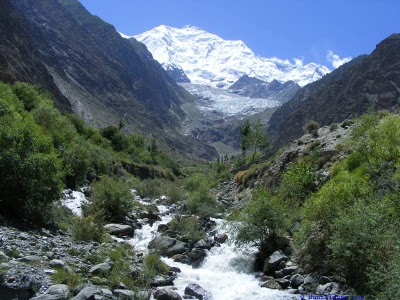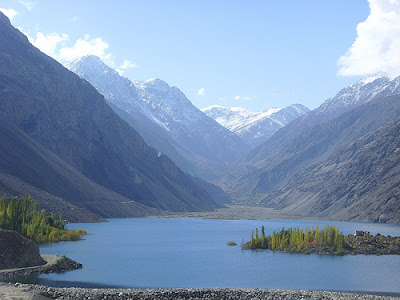The Hunza Valley is a mountainous valley in Gilgit in the Gilgit-Baltistan autonomous region, an area under the control of the government of Pakistan. The Hunza valley is situated to the north of the Hunza River, at an elevation of around 2,500 metres (8,200 ft). The territory of Hunza is about 7,900 square kilometres (3,100 sq mi). Karimabad (formerly called Baltit) is the main town, which is also a very popular tourist destination because of the spectacular scenery of the surrounding mountains like Ultar Sar, Rakaposhi, Bojahagur Duanasir II, Ghenta Peak, Hunza Peak, Diran Peak and Bublimating (Ladyfinger Peak), all 6,000 metres (19,685 ft) or higher.
The visitors to Hunza are overwhelmed by the rugged charm, the fragrant breeze singing through graceful Poplar trees and the velvet-like green carpet of wheat fields, set against the background of snow-covered mountains.
Hunza Valley's tourist season is from April to October. The temperature in May is maximum 27 C and minimum 14 C. The October temperature are: maximum 10 C and minimum 0 C. However, one can visit Hunza round the year.
Most of the people of Hunza are Ismaili Muslims, followers of His Highness the Aga Khan. The local language is Brushuski. Urdu and English are also understood by most of people.
Karimabad, the capital of Hunza, offers an awe-inspiring view of Rakaposhi 7,788 metres. The snows of Rakaposhi glitter in the moonlight, producing an atmosphere at once ethereal and sublime.
The fairy-tale like castle of Baltit, above Karimabad, is a Hunza landmark built about 600 years ago. Stilted on massive legs, its wooden bay windows look out over the valley. Originally, it was used as the residence of the Mirs (the title of the former rulers) of Hunza.
Mountaineering And Hiking
Hunza is ideal for mountaineering, trekking and hiking. Most of the treks in Hunza area are in open zone, for which tourists do not need any permit. However special permits are required from the Ministry of Tourism, Islamabad for mountaineering, trekking in restricted zone & climbing peaks over 6000 metres.
How to Get There:
Regular Bus and Van Services operate between Gilgit and Karimabad. PTDC Office at Chinnar Inn, Gilgit, arranges tours and transport for visitors.

The visitors to Hunza are overwhelmed by the rugged charm, the fragrant breeze singing through graceful Poplar trees and the velvet-like green carpet of wheat fields, set against the background of snow-covered mountains.
Hunza Valley's tourist season is from April to October. The temperature in May is maximum 27 C and minimum 14 C. The October temperature are: maximum 10 C and minimum 0 C. However, one can visit Hunza round the year.
Most of the people of Hunza are Ismaili Muslims, followers of His Highness the Aga Khan. The local language is Brushuski. Urdu and English are also understood by most of people.
Karimabad, the capital of Hunza, offers an awe-inspiring view of Rakaposhi 7,788 metres. The snows of Rakaposhi glitter in the moonlight, producing an atmosphere at once ethereal and sublime.
The fairy-tale like castle of Baltit, above Karimabad, is a Hunza landmark built about 600 years ago. Stilted on massive legs, its wooden bay windows look out over the valley. Originally, it was used as the residence of the Mirs (the title of the former rulers) of Hunza.
Mountaineering And Hiking
Hunza is ideal for mountaineering, trekking and hiking. Most of the treks in Hunza area are in open zone, for which tourists do not need any permit. However special permits are required from the Ministry of Tourism, Islamabad for mountaineering, trekking in restricted zone & climbing peaks over 6000 metres.
How to Get There:
Regular Bus and Van Services operate between Gilgit and Karimabad. PTDC Office at Chinnar Inn, Gilgit, arranges tours and transport for visitors.
Sights of Hunza
The spellbinding beauty of the valley and its magnificent mountain peaks has made Hunza a favorite spot of tourists allover the world. It is a mountaineer’s, nature lover’s and a photographer’s dream. Some must see sights of Hunza are its mountain peaks, forts and the bazaar.
Rakaposhi MountainIt is a part of the Karakoram Mountain range and is 7,788 meters high. Also known as Dumani (Mother of Mist), Rakaposhi Mountain can be seen from many parts of Hunza. The word Rakaposhi means “Shinning Wall” most probably because it is surrounded by famous glacier valleys like Barpu, Biro, Bagrot and Pisan. It is the 12th highest mountain peak of Pakistan and is famous for its scenic beauty.
Ultra Sar
It is also a part of the Karakoram Range and is situated at an approximate distance of 10 km northeast of Karimabad (capital of Hunza). Till 1996 it enjoyed the reputation of being the inaccessible peak of the world.
Other peaks worth watching are the Hunza Peak, the Bublimanting or Lady Finger Peak and Golden Peak.
The Baltit Fort
The Baltit Fort is a magnificent structure 700 years old and was the residence of the rulers. Over the years it under went many alterations and then in 1996 it was taken over and restored by the Aga Khan Trust For Culture Historic Cities Support Program and now serves as a museum.. It sits on top of Karimabad. Stilted on massive legs it is a must see on every tourists list.
Altit Fort
Altit Fort was also the residence of the rulers. It is said to be a century older than the Baltit Fort and lies at the foot of the valley. Due to negligence of the government it was in ruins but now it is also being restored by the Aga Khan Trust for Culture Historic Cities Support Program.
The local handicrafts can be purchased from the colorful bazaar of Hunza.
















































